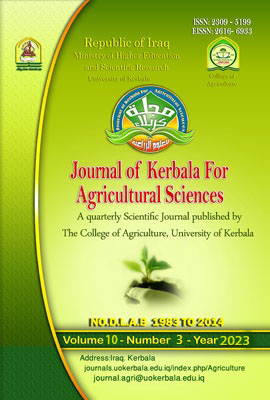Response of growth, yield and quality of maize to the fertilizer combi-nation of nitrogen and potassium and spraying with the potassium humate
DOI:
https://doi.org/10.59658/jkas.v10i3.1244Keywords:
Maize) Zea mays L.), Fertilizer combination, nitrogen and potas-sium, potassium humate, spraying.Abstract
The split-plot experiment was carried out in one of the agricultural fields- Al-Hussainiya district in the holy city of Kerbala for the fall season 2022, by planting the maize, Sumer cultivar was planted in a soil with clay loam texture. The experiment comprising two factors, and the first factor was the combinations of different levels of nitrogen (0, 150 and 300 kg N ha-1) were identified with symbols, N0, N1, and N2, respectively, Three levels of potassium (0, 80 and 160 kg K ha-1) were symbolized as K0, K1, and K2, respectively, the second factor was spraying with the organic nutrient potassium humate at two concentrations (1 and 2) g L-1, the concentrations of potassium humate were occupied the main plots, while the fertilizer combinations of nitrogen and potassium filled the sub plots with three replications according to the randomized complete block design (RCBD).The results showed a significant effect of adding fertilizer combinations of nitrogen and potassium and spraying with the organic nutrient potassium humate (2 g L-1) individually and overlapping in most growth, yield and quality traits, as the overlapping showed a significant superiority in increasing of leaf area (cm2 plant-1), stem diameter (mm), leaf chlorophyll index (SPAD unit), ear weight (g), plant yield (g plant-1) and protein yield (g plant-1), the interaction between the two study factors contributed to reducing the amount of mineral fertilizer to 50%, as there was no significant difference between the fertilizer combinations of nitrogen and potassium (150N + 80K) and (300N + 160K) Kg ha-1, with a concentration of 2 gmL-1 of potassium humate.
Downloads
Published
How to Cite
Issue
Section
License
Copyright (c) 2023 Copyright (c) 2024 is the Author's article. Published by the Journal of Kerbala for Agricultural Sciences under a CC BY 4.0 license

This work is licensed under a Creative Commons Attribution 4.0 International License.
Licensing Terms
All articles are published under a Creative Commons License and will be directed to the Creative Commons Attribution 4.0 International License (CC BY 4.0) That permits use, distribution, and reproduction in any medium, provided the original work is properly cited. This license also allows the work to be used for commercial purposes.
Use by both non-commercial and commercial users
This content is licensed under a Creative Commons Attribution 4.0 International (CC BY 4.0) license, permitting use by both non-commercial and commercial users. Individual users may access, download, copy, display, and redistribute the articles to colleagues, as well as adapt, translate, and text- and data-mine the content, subject to the following conditions:
- The author's moral rights, including the right of attribution and the right to protect their work from derogatory treatment, are respected.
- Where content in the article is identified as belonging to a third party, users must ensure that any reuse complies with the copyright policies of the owner of that content.
- If the article content is reused for research or educational purposes, users should maintain a link to the appropriate bibliographic citation, including the DOI and a link to the published version on the journal's website.






